The coronation of King Charles III took place over the weekend of 6 May 2023 at Westminster Abbey, where the Archbishop of Canterbury also officiated the coronation of The Queen Consort.
The Palace promised a coronation weekend that reflected “the Monarch’s role today and looks towards the future”. The event – said to be costing in the region of £100 million – was also said to be “rooted in longstanding traditions and pageantry”.
But alongside the royal supporters lining the procession route were protesters, their banners exclaiming “Not My King”. The coronation of Charles III was set to look very different from that of his mother, Elizabeth II, almost seven decades earlier.
Keep reading for a look back at the coronation of King Charles III, how the weekend was celebrated here in Kent, and where the King’s wealth really resides.
A packed coronation weekend
Saturday’s pageantry saw “The King’s Procession” travel from Buckingham Palace to Westminster Abbey. The King chose the Diamond Jubilee State Coach for the journey – the last coach made during the reign of his mother.
After nearly two hours – a slimmed down service compared to the three-hour ceremony of Elizabeth II back in 1953 – “The Coronation Procession” saw the King and the Queen Consort return to Buckingham Palace, where members of the Royal Family appeared on the balcony.
The following day, Sunday 7 May, the Coronation Concert at Windsor Castle saw the likes of Take That, Lionel Richie and Katy Perry perform for the King and Queen Consort, alongside Andrea Bocelli, Sir Bryn Terfel, and the Coronation Choir, comprised of diverse choir groups from across the UK.
This was followed, on Monday, by the Big Help Out. This saw organisations like the Scouts, the Royal Voluntary Service and faith groups from across the UK highlight the positive impact that volunteering can have on communities.
The cost of the crown saw silent protests
While millions of Brits celebrated alongside our new King and Queen Consort, the Guardian had previously reported on a YouGov poll that found 64% of us “didn’t care very much” or “didn’t care at all” about the event. Just 9% claimed they “cared a great deal”.
The cost of the event – said to be around £100 million – might’ve been partly to blame, especially during a cost of living crisis and in light of recent well-publicised estimates of the Royal Family’s wealth.
For example, King Charles III was recently reported to be worth more than £1.8 billion.
The quoted figures included:
- A fleet of royal cars and carriages (including Rolls-Royces, Bentleys and Jaguars) worth around £6.3 million
- Private property worth around £330 million, including two estates inherited from his mother: Balmoral in the Scottish Highlands and Sandringham in Norfolk, bought in 1862 by Queen Victoria
- 70 thoroughbred racehorses with a total estimated value of £27 million (although Charles has already sold some at auction, for an estimated £2.3 million)
- Around 400 artworks, including pieces by Dalí, Monet, Freud, Chagall and Lowry. Just 40 of the most significant of these works have been given a total value of £24 million. Privately held jewels, meanwhile, have been valued at around £533 million
- The Duchy of Lancaster, “a private estate held in trust for the sovereign”, which pays directly to the King and is currently worth around £653 million.
Charles also holds private investments that are known only to the Windsor family and so can’t be accurately estimated.
Note: The above figures come from a report in the Guardian into Charles’s wealth, which the King’s spokesman referred to as a “highly creative mix of speculation, assumption and inaccuracy”.
Police officers from around the UK descended on the capital as part of Operation Golden Orb, providing security along the route and ensuring that the protests remained peaceful and “non-disruptive”.
The event saw 52 arrests amid accusations of heavy-handedness that the Metropolitan Police have denied.
Huge numbers got involved all weekend
Coverage of the big day began in the early hours of Saturday morning, with viewer numbers peaking at more than 20 million around midday when the King was crowned.
The BBC attracted the largest share of viewers by far, peaking at around 15 million. Though high, viewing figures were 9 million down on the number that watched Queen Elizabeth II’s funeral in September 2022.
Rochester Castle Gardens live-streamed the event from 10 am, where the audience was joined by stilt walkers, roaming characters, a Punch and Judy show, and fun fair rides. At noon, a 21 Gun Royal Salute rang out from Fort Amherst, where the tradition of firing ceremonial salutes stretches back to 1756.
Get in touch
Your wealth might not match that of King Charles III, but if you would like to discuss how best to manage your money and long-term retirement plans, speak to us now.
Get in touch by emailing hello@fingerprintfp.co.uk or calling 03452 100 100.

